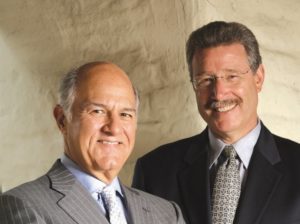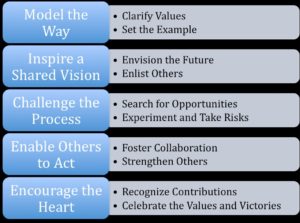 There are two very influential books in my leadership journey. One of those is Marshall Goldsmith’s What Got You Here Won’t Get You There (2007, Hyperion); the other is The Leadership Challenge by Kouzes and Posner (Jossey-Bass, 2012). I have talked about both of these works and their authors in previous posts. The Leadership Challenge was introduced to me in the MA (Leadership) program at Royal Roads University as a text and part of the learning. It resonated with me right away as it described perfectly the leadership style that I had been using in my career as a sales manager and senior leader in my organization.
There are two very influential books in my leadership journey. One of those is Marshall Goldsmith’s What Got You Here Won’t Get You There (2007, Hyperion); the other is The Leadership Challenge by Kouzes and Posner (Jossey-Bass, 2012). I have talked about both of these works and their authors in previous posts. The Leadership Challenge was introduced to me in the MA (Leadership) program at Royal Roads University as a text and part of the learning. It resonated with me right away as it described perfectly the leadership style that I had been using in my career as a sales manager and senior leader in my organization.
The model described by Kouzes and Posner (K&P) provides a language and framework for which I had been looking. It also builds on the Hersey-Blanchard Situational Leadership Model that I covered in last week’s post and other transformational leadership models. K&P provide definitions and descriptors of the skills required by leaders to create transformation in the workplace and to influence followers, bringing them to accept the leader’s vision as their own.
An Introduction to Kouzes and Posner
The benchmark for The Leadership Challenge Model (TLC) is the Leadership Practices Inventory (LPI). Over three million people have taken this 360° survey, which has enabled K&P to validate the results over and over again. On top of that, there have been hundreds of independent research papers written about this model, and many PHD theses.
The Model identifies five abilities that are crucial to successful leadership:
- Model the Way: In simple daily acts, effective leaders set an example for others as they Model the Way—from the stories they tell, the way they allocate their time, and the language they use, to the recognitions, rewards, and measurement tools they choose. In putting this essential practice into action, leaders build commitment by affirming and communicating shared values that all can embrace, and engaging others in achieving common goals
- Inspire a Shared Vision: Without willing followers, there can be no leaders. And Inspiring a Shared Vision is the practice that sets leaders apart from other credible people. Leaders engage others in tying their personal dreams to the aspirations of the group to create a shared vision. Only then will these followers commit their talents, time, and energy to working together to achieve greatness.

- Challenge the Process: The work of leaders is change, and making a commitment to Challenge the Process requires a willingness to take action, every day: to look outward for innovative ways to improve, to experiment and take risks, to constantly generate small wins—making it easy for the team to succeed in making progress—and to learn continually from experience.
- Enable Others to Act: Leaders make sure that when they win, everybody wins. They share power and information as well as build the capabilities and capacities of others to be successful. Leaders act as coaches and teachers, giving people challenging tasks, clearing away obstacles, and supporting others with the tools they need to be successful. By fostering collaboration, building trust, and facilitating relationships, leaders Enable Others to Act with increased self-determination and competence.
- Encourage the Heart: Leaders Encourage the Heart by putting into action the principles and essential practices that support our basic human need to be appreciated for who we are and for what we do. In big ways and small—from marching bands and T-shirts to a simple and heartfelt “thank you”—leaders recognize contributions by showing appreciation for individual excellence and celebrate the values and victories by creating a spirit of community.
(The Five Practices of Exemplary Leadership, 2009, Pfeiffer an Imprint of Wiley)
The foundational element to this Model is the concept that leaders can be made. That anyone can improve their leadership abilities, because most of us are already leaders in the various walks of our life. Those of you who have followed my posts will understand where I am coming from and the many examples I have used to illustrate this point. Recognizing this principle allows us to then understand that for leaders to improve, they need to increase the frequency of credibility-enhancing behaviours, or as K&P put it, “If you don’t believe in the messenger, you won’t believe the message.”
This is the third on a series specifically exploring what leadership is and how we can not only understand leadership but how to implement it
Leadership series directory:
Leadership is…. Three Theories of Leadership
Directing, Coaching, Supporting & Delegating Are What?
John Whitehead, coaches’ individuals and organizations in becoming more effective by helping them improve their interpersonal communications, emotional intelligence and resiliency.
*******Are you wondering if having a Leadership/Personal Development Coach is right for you? Contact John for a complimentary, exploratory coaching session at [email protected]********
If you would like to get notifications for when I post, please go to my blog site and register. I promise I will not spam or use your email address for anything else. You can visit and register for my blog at https://johnkwhitehead.ca/blog-2/

Pingback: Leadership vs Management – Encourager! -
Pingback: Leadership is... About Who We Are Leading -